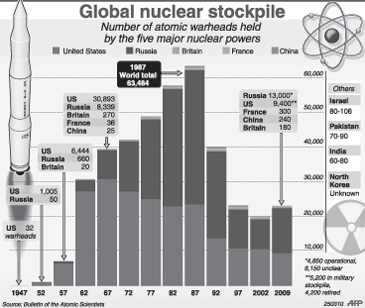WASHINGTON, March 27, (AFP) -US President Barack Obama and his Russian counterpart Dmitry Medvedev have finalized a historic new deal to cut long-range nuclear arms, argeeing to slash the number of deployed warheads by a third.
After months of intense negotiations, the pair sealed what Obama called “the most comprehensive arms control agreement in nearly two decades,” as they hailed improved ties that hit a low under US president George W. Bush.
 |
| US President Barack Obama is accompanied by US Secretary of State Hillary Clinton (not seen in pic) and Secretary of Defence Robert Gates as he arrives to give an unscheduled press briefing at the White House in Washington, DC, on March 26. AFP |
The new pact, due to be signed April 8 in Prague by both the presidents of the former Cold War foes, replaces the landmark 1991 Strategic Arms Reduction Treaty (START), which expired in December.
In the Czech capital last year, Obama unveiled a plan to purge the world of atomic weapons by cutting stockpiles, curtailing testing, choking fissile production and securing loose nuclear material.
Obama -- standing Friday next to Secretary of State Hillary Clinton, Defense Secretary Robert Gates and other key officials -- stressed that the new START treaty was a “fundamental part of that effort” for a nuclear-free world.
He said the deal also advances his priority to “reset” ties between the two countries, which have deepened cooperation on the US-led war against Muslim extremists in Afghanistan and on efforts to curb Iran's nuclear ambitions.
In Moscow, the Kremlin said “the presidents agreed that the new treaty marks the transfer of Russian-US cooperation to a higher level in the development of new strategic ties.”The Union of Concerned Scientists (UCS) warmly welcomed the treaty.“This treaty will send a powerful, unambiguous message to the rest of the world that the United States and Russia are serious about reducing the nuclear threat,” the UCS's Sean Meyer said in a statement.
“And the timing couldn't be better, given President Obama is hosting an international nuclear security summit in April and the Nuclear Non-Proliferation Treaty review conference in May,” he said.
Obama said the treaty “significantly reduces” US and Russian missiles and launchers, and sets up a “strong and effective” verification regime.
It specifies limits of 1,550 deployed warheads, which is about 30 percent lower than a previous upper warhead limit set in 2002.
The UCS said the new treaty counts each deployed missile warhead as one, and each deployed bomber as one warhead, and under these rules, currently the United States has 1,762 warheads and Russia has 1,741.
“The treaty does not cover the thousands of warheads both countries have in storage,” it said in a statement.
The treaty limits missile forces to 800 deployed and non-deployed intercontinental ballistic missile launchers, submarine launched ballistic missile launchers, and heavy bombers equipped for nuclear weapons.
The cap on deployed intercontinental ballistic missiles and submarine launched missiles is set at 700, the White House said.
Clinton, who traveled to Moscow last week in a bid to clear the last hurdles to the deal, said she was “confident” the Obama administration would be able to convince the Senate to ratify the treaty.
A senior State Department official said the treaty will be “submitted for ratification in late spring.”Obama's Senate ally John Kerry, who chairs the chamber's foreign relations committee, urged Republicans to end the feuding.
“We can't squander this opportunity to reset both our relations with Russia and our role as the world leader on nuclear nonproliferation,” he said. |



